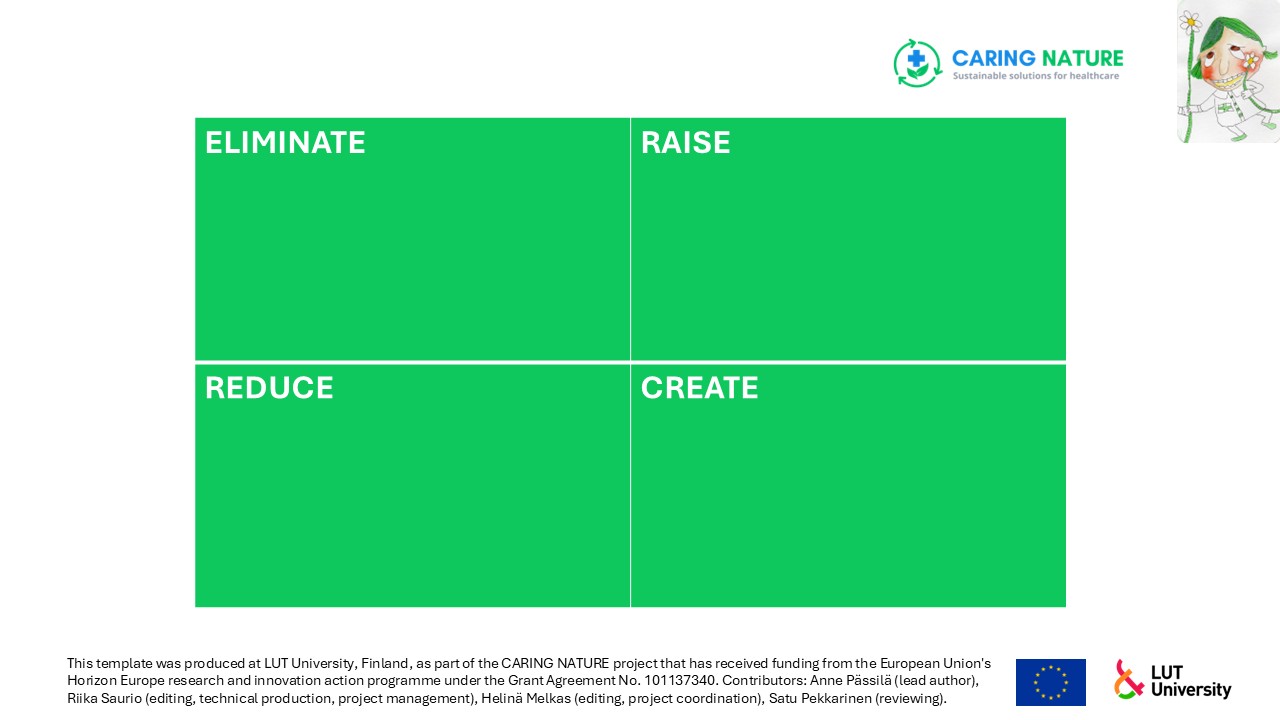THE BLUE OCEAN STRATEGY 2 X 2 MATRIX FOR ANALYSING OPERATING ENVIRONMENTS OF THE GREEN TRANSITION
Paradigm-preserving methods
The Blue Ocean Strategy 2 × 2 matrix is a tool that helps organisations or teams to analyse their operating environment and develop innovative solutions. It is based on Kim and Mauborgne's (2005) Blue Ocean Strategy model.
In the context of the green transition, the 2 x 2 matrix is applied to and emphasises the creation of new possibilities for action, rather than remaining stuck in existing ways of doing things. The matrix can be used to identify which existing policies or practices should be eliminated and which should be reduced, as well as which policies should be raised, and which new policies should be created to build a new policy environment for the health and care organisation or system.
What is required:
- From the group: openness to innovative thinking and willingness to challenge the prevailing practices
- From the facilitator: ability to steer the discussion towards strategic solutions and expertise in sustainable development and the green transition
- Knowledge of the current situation such as the organisation's environmental programme and strategy and green transition related measures
- If the organisation does not have an environmental programme and strategy, you should familiarise yourself with the environmental programme and strategy of another organisation and the related practical measures. The matrix can be used to design your own organisation's environmental programme and strategy.
Level of difficulty: 2–3 (moderate - requires analysis and strategic thinking)
Time required: 30-90 min, depending on the topic and the size of the group
Materials:
- A flipchart or whiteboard
- Markers and notepads
- Digital tools (such as Miro, MURAL) for remote use
- Knowledge of your organisation's environmental programme and strategy and familiarisation with other organisations' environmental programmes and strategies
Participants: 3-10 people, can be an in-house or a multi-professional team
How to use:
- Define the topic to be analysed
- Draw a matrix with four parts:
- Eliminate - what can be eliminated? (Outdated, redundant practices)
- Reduce - what can be reduced? (Overemphasised factors that have less value for the environment and the green transition)
- Raise - what existing factors can be strengthened? (Practices that add value to the green transition)
- Create - what can be developed that is completely new? (Innovative solutions to create new policies, processes and practices for the green transition)
- Fill in the four parts of the matrix - discuss each item and write down your ideas.
- Prioritise the most important actions - which elements bring the biggest added value and strategic advantage to the green transition?
- Formulate an action plan - how can the ideas identified be put into practice?
When to use:
- In the development of an environmental strategy and the early stages of green transition related innovation processes
- In the development of a new sustainable solution, service, process, policy or practice
- In the analysis and renewal of an organisation's or team's internal environmental programme and related activities
Why to use:
- Helps to identify and create new opportunities
- Allows to focus on the essentials and eliminate the unnecessary
- Creates a systematic basis for innovation
- Provides a visual and easy structure for strategic thinking
How to document:
- The completed matrix can be photographed or digitally stored
- Key findings and priorities are recorded
- Proposed actions are translated into concrete objectives
The roots of the method can be found here: The Blue Ocean Strategy 2 x 2 matrix is based on Kim and Mauborgne's (2005) Blue Ocean Strategy model, which emphasises the creation of new markets rather than competition. The model is also related to strategic innovation (Hamel & Prahalad, 1994) and value-based business development (Porter, 1985). The 2 x 2 matrix supports incremental and radical innovation (Christensen, 1997) and value creation for customers.
